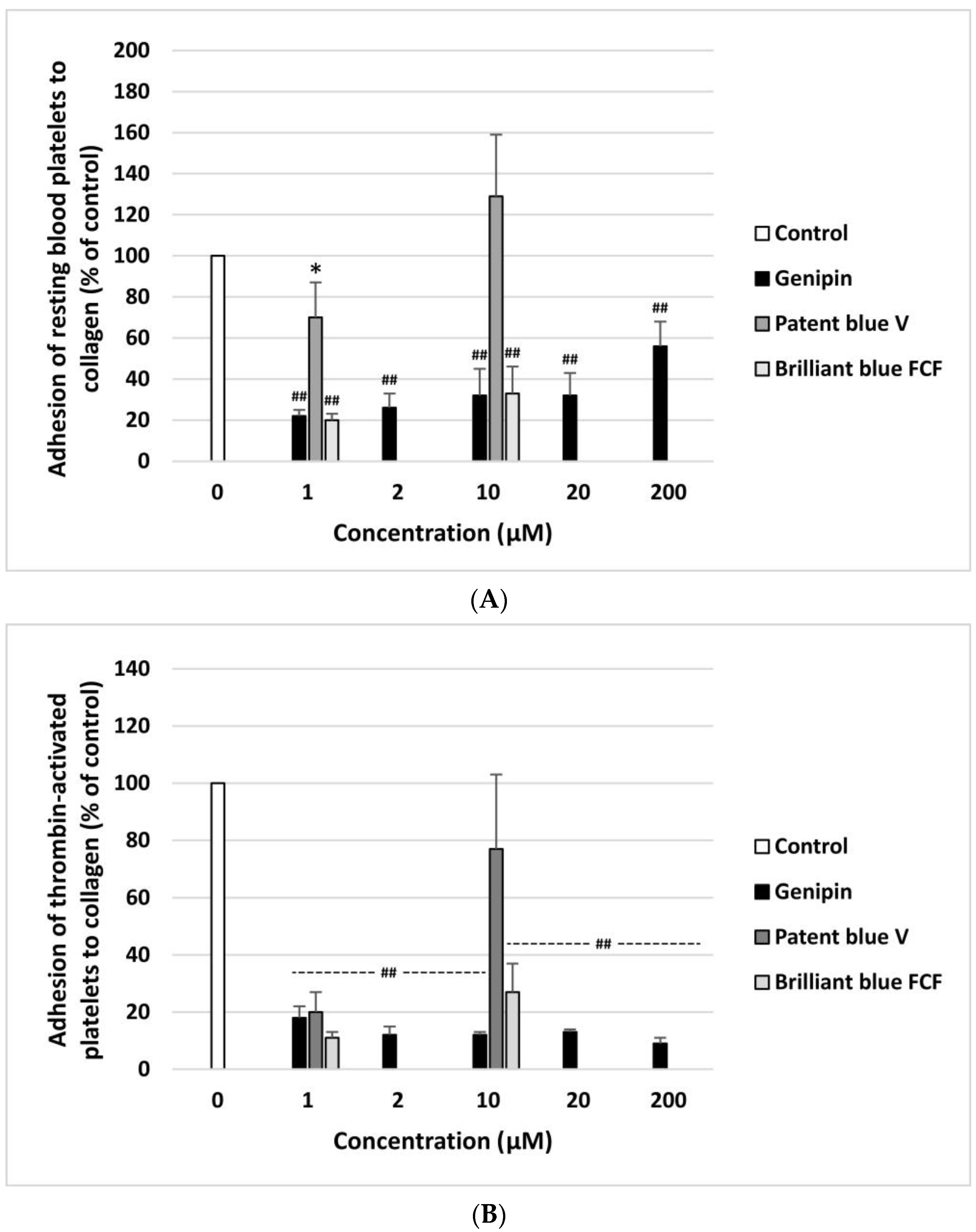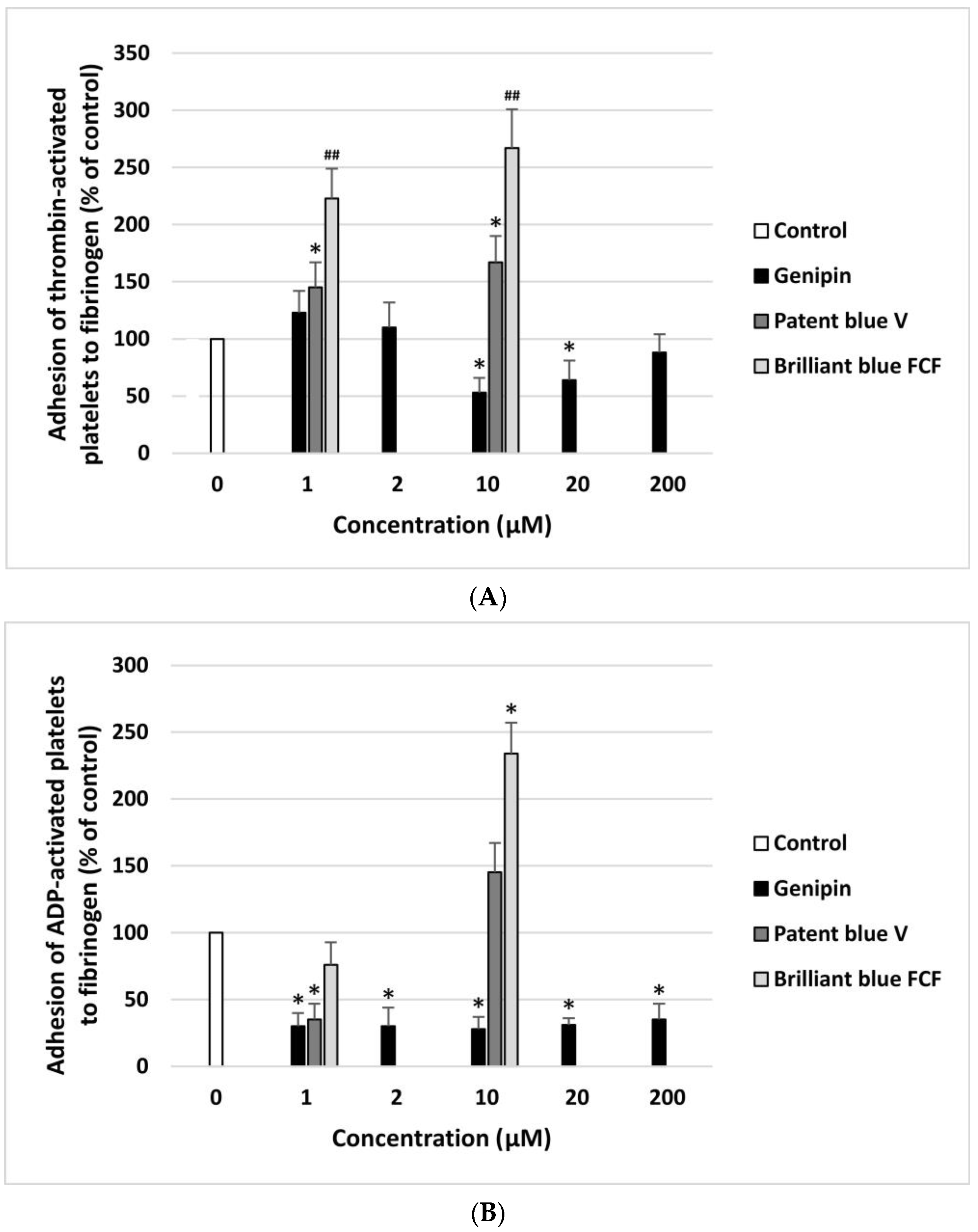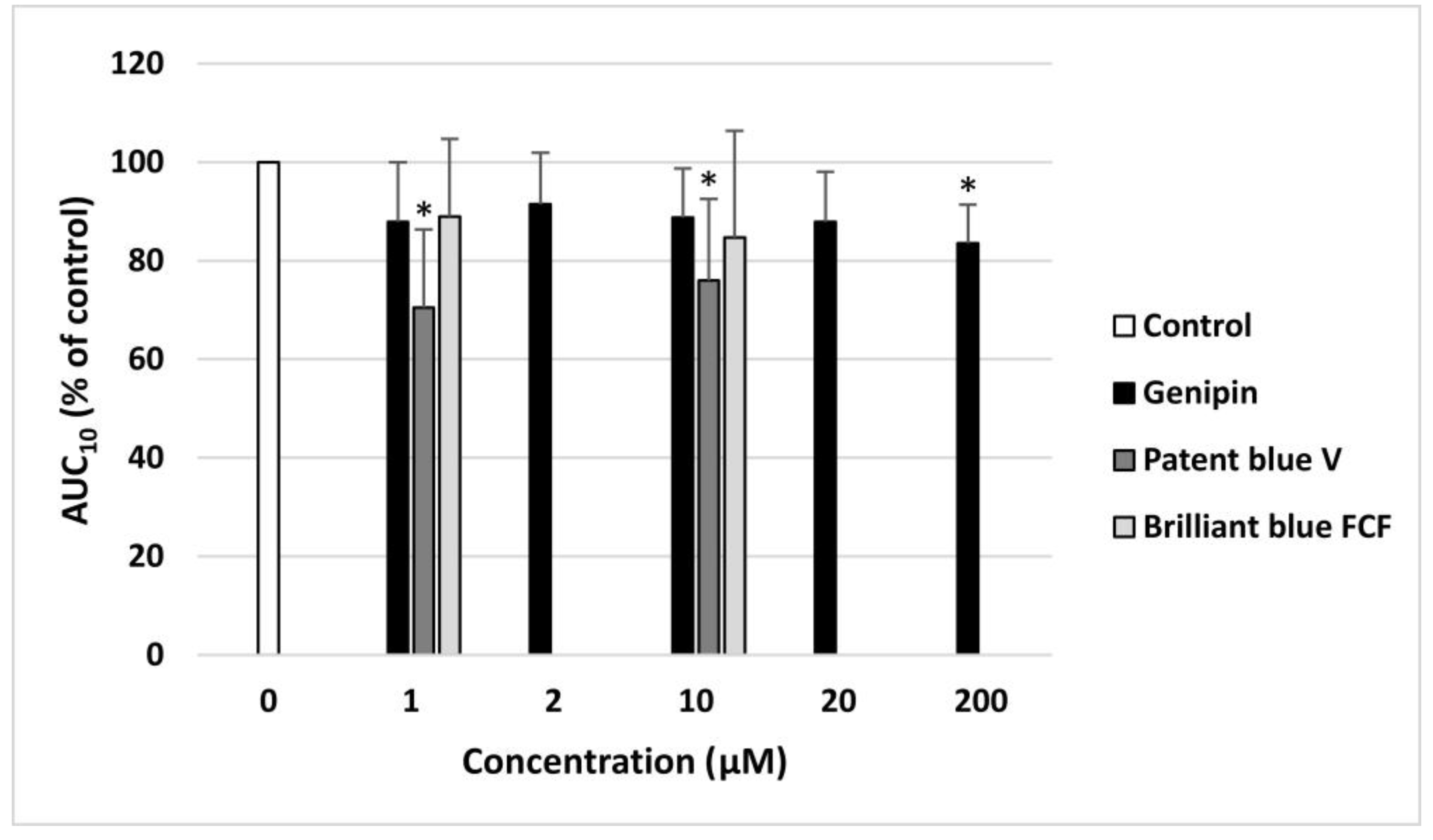New Findings Regarding the Effects of Selected Blue Food Colorants (Genipin, Patent Blue V, and Brilliant Blue FCF) on the Hemostatic Properties of Blood Components In Vitro
Abstract
1. Introduction
2. Materials and Methods
2.1. Chemical Reagents
2.2. Preparation of the Stock Solution of the Tested Colorants
2.3. Blood, Plasma, and Blood Platelet Samples
2.4. Effect of the Tested Colorants on the Hemostasis Parameters
2.4.1. Platelet Adhesion
2.4.2. Measurement of Thrombin Time, Prothrombin Time, and Activated Partial Thromboplastin Time
2.4.3. Total Thrombus Formation Analysis System (T-TAS) (PL-Chip)
2.5. Effect of the Tested Colorants on the Parameters of Cell Damage
Activity of LDH
2.6. Statistical Analysis
3. Results
3.1. Measurement of Blood Platelet Adhesion to Collagen and Fibrinogen
3.2. Measurement of the Coagulation Times (TT, PT, and APTT)
3.3. Measurement of Thrombus Formation with the T-TAS (PL-Chip)
3.4. Measurement of Cytotoxicity
4. Discussion
5. Conclusions
Author Contributions
Funding
Institutional Review Board Statement
Informed Consent Statement
Data Availability Statement
Conflicts of Interest
Abbreviations
References
- Flora, G.D.; Nayak, M.K. A Brief Review of Cardiovascular Diseases, Associated Risk Factors and Current Treatment Regimes. Curr. Pharm. Des. 2019, 25, 4063–4084. [Google Scholar] [CrossRef] [PubMed]
- Ohmura, H. Triglycerides as Residual Risk for Atherosclerotic Cardiovascular Disease. Circ. J. 2019, 83, 969–970. [Google Scholar] [CrossRef] [PubMed]
- Virani, S.S.; Newby, L.K.; Arnold, S.V.; Bittner, V.; Brewer, L.C.; Demeter, S.H.; Dixon, D.L.; Fearon, W.F.; Hess, B.; Johnson, H.M.; et al. 2023 AHA/ACC/ACCP/ASPC/NLA/PCNA Guideline for the Management of Patients With Chronic Coronary Disease: A Report of the American Heart Association/American College of Cardiology Joint Committee on Clinical Practice Guidelines. Circulation 2023, 148, e9–e119. [Google Scholar] [CrossRef] [PubMed]
- Arnett, D.K.; Blumenthal, R.S.; Albert, M.A.; Buroker, A.B.; Goldberger, Z.D.; Hahn, E.J.; Himmelfarb, C.D.; Khera, A.; Lloyd-Jones, D.; McEvoy, J.W.; et al. 2019 ACC/AHA Guideline on the Primary Prevention of Cardiovascular Disease: A Report of the American College of Cardiology/American Heart Association Task Force on Clinical Practice Guidelines. Circulation 2019, 140, e596–e646. [Google Scholar] [CrossRef] [PubMed]
- Santhakumar, A.B.; Battino, M.; Alvarez-Suarez, J.M. Dietary Polyphenols: Structures, Bioavailability and Protective Effects against Atherosclerosis. Food Chem. Toxicol. 2018, 113, 49–65. [Google Scholar] [CrossRef] [PubMed]
- Vazhappilly, C.G.; Ansari, S.A.; Al-Jaleeli, R.; Al-Azawi, A.M.; Ramadan, W.S.; Menon, V.; Hodeify, R.; Siddiqui, S.S.; Merheb, M.; Matar, R.; et al. Role of Flavonoids in Thrombotic, Cardiovascular, and Inflammatory Diseases. Inflammopharmacology 2019, 27, 863–869. [Google Scholar] [CrossRef] [PubMed]
- Lutz, M.; Fuentes, E.; Ávila, F.; Alarcón, M.; Palomo, I. Roles of Phenolic Compounds in the Reduction of Risk Factors of Cardiovascular Diseases. Molecules 2019, 24, 366. [Google Scholar] [CrossRef] [PubMed]
- Ed Nignpense, B.; Chinkwo, K.A.; Blanchard, C.L.; Santhakumar, A.B. Polyphenols: Modulators of Platelet Function and Platelet Microparticle Generation? Int. J. Mol. Sci. 2019, 21, 146. [Google Scholar] [CrossRef] [PubMed]
- Olas, B.; Urbańska, K.; Bryś, M. Selected Food Colourants with Antiplatelet Activity as Promising Compounds for the Prophylaxis and Treatment of Thrombosis. Food Chem. Toxicol. 2020, 141, 111437. [Google Scholar] [CrossRef]
- Khoo, H.E.; Azlan, A.; Tang, S.T.; Lim, S.M. Anthocyanidins and Anthocyanins: Colored Pigments as Food, Pharmaceutical Ingredients, and the Potential Health Benefits. Food Nutr. Res. 2017, 61, 1361779. [Google Scholar] [CrossRef]
- Kaur, K.; Sharma, R.; Singh, S. Bioactive Composition and Promising Health Benefits of Natural Food Flavors and Colorants: Potential beyond Their Basic Functions. Pigment. Resin. Technol. 2019, 49, 110–118. [Google Scholar] [CrossRef]
- Wang, H.; Yin, Y.; Zhu, J.; Zhu, Z.; Li, Q. Current Status of Health Food Regulation and Standards in the United States. J. Food Saf. Qualit. 2019, 10, 19–24. [Google Scholar]
- Olas, B.; Białecki, J.; Urbańska, K.; Bryś, M. The Effects of Natural and Synthetic Blue Dyes on Human Health: A Review of Current Knowledge and Therapeutic Perspectives. Adv. Nutr. 2021, 12, 2301–2311. [Google Scholar] [CrossRef] [PubMed]
- Lehto, S.; Buchweitz, M.; Klimm, A.; Straßburger, R.; Bechtold, C.; Ulberth, F. Comparison of Food Colour Regulations in the EU and the US: A Review of Current Provisions. Food Addit. Contam. Part A 2017, 34, 335–355. [Google Scholar] [CrossRef] [PubMed]
- U.S. Food and Drug Administration. Summary of Color Additives for Use in the United States in Foods, Drugs, Cosmetics, and Medical Devices. Available online: https://www.fda.gov/industry/color-additive-inventories/summary-color-additives-use-united-states-foods-drugs-cosmetics-and-medical-devices (accessed on 11 June 2024).
- Yusuf, M.; Shabbir, M.; Mohammad, F. Natural Colorants: Historical, Processing and Sustainable Prospects. Nat. Prod. Bioprospect 2017, 7, 123–145. [Google Scholar] [CrossRef] [PubMed]
- Xiao, W.; Li, S.; Wang, S.; Ho, C.-T. Chemistry and Bioactivity of Gardenia jasminoides. J. Food Drug Anal. 2017, 25, 43–61. [Google Scholar] [CrossRef] [PubMed]
- Neri-Numa, I.A.; Pessoa, M.G.; Paulino, B.N.; Pastore, G.M. Genipin: A Natural Blue Pigment for Food and Health Purposes. Trends Food Sci. Technol. 2017, 67, 271–279. [Google Scholar] [CrossRef]
- Bryś, M.; Urbańska, K.; Olas, B. Novel Findings Regarding the Bioactivity of the Natural Blue Pigment Genipin in Human Diseases. Int. J. Mol. Sci. 2022, 23, 902. [Google Scholar] [CrossRef]
- Ahmed, R.; ul ain Hira, N.; Wang, M.; Iqbal, S.; Yi, J.; Hemar, Y. Genipin, a Natural Blue Colorant Precursor: Source, Extraction, Properties, and Applications. Food Chem. 2024, 434, 137498. [Google Scholar] [CrossRef]
- Jaafar, A.; Zulkipli, M.A.; Mohd Hatta, F.H.; Jahidin, A.H.; Abdul Nasir, N.A.; Hazizul Hasan, M. Therapeutic Potentials of Iridoids Derived from Rubiaceae against in Vitro and in Vivo Inflammation: A Scoping Review. Saudi Pharm. J. 2024, 32, 101876. [Google Scholar] [CrossRef]
- Fan, X.; Lin, L.; Cui, B.; Zhao, T.; Mao, L.; Song, Y.; Wang, X.; Feng, H.; Qingxiang, Y.; Zhang, J.; et al. Therapeutic Potential of Genipin in Various Acute Liver Injury, Fulminant Hepatitis, NAFLD and Other Non-Cancer Liver Diseases: More Friend than Foe. Pharmacol. Res. 2020, 159, 104945. [Google Scholar] [CrossRef]
- Olas, B.; Wachowicz, B.; Tomczak, A.; Erler, J.; Stochmal, A.; Oleszek, W. Comparative Anti-Platelet and Antioxidant Properties of Polyphenol-Rich Extracts from: Berries of Aronia Melanocarpa, Seeds of Grape and Bark of Yucca Schidigera In Vitro. Platelets 2008, 19, 70–77. [Google Scholar] [CrossRef]
- Skalski, B.; Rywaniak, J.; Szustka, A.; Żuchowski, J.; Stochmal, A.; Olas, B. Anti-Platelet Properties of Phenolic and Nonpolar Fractions Isolated from Various Organs of Elaeagnus rhamnoides (L.) A. Nelson in Whole Blood. Int. J. Mol. Sci. 2021, 22, 3282. [Google Scholar] [CrossRef]
- Slusarewicz, P.; Zhu, K.; Hedman, T. Kinetic Analysis of Genipin Degradation in Aqueous Solution. Nat. Prod. Commun. 2010, 5, 1853–1858. [Google Scholar] [CrossRef]
- EFSA Panel on Food Additives and Nutrient Sources added to Food (ANS). Scientific Opinion on the Re-evaluation of Patent Blue V (E 131) as a Food Additive. EFSA J. 2013, 11, 2818. [Google Scholar] [CrossRef]
- Amchova, P.; Kotolova, H.; Ruda-Kucerova, J. Health Safety Issues of Synthetic Food Colorants. Regul. Toxicol. Pharmacol. 2015, 73, 914–922. [Google Scholar] [CrossRef]
- Zhou, J.; Yao, N.; Wang, S.; An, D.; Cao, K.; Wei, J.; Li, N.; Zhao, D.; Wang, L.; Chen, X.; et al. Fructus Gardeniae-Induced Gastrointestinal Injury Was Associated with the Inflammatory Response Mediated by the Disturbance of Vitamin B6, Phenylalanine, Arachidonic Acid, Taurine and Hypotaurine Metabolism. J. Ethnopharmacol. 2019, 235, 47–55. [Google Scholar] [CrossRef] [PubMed]
- Genipin PubChem Record. Available online: https://pubchem.ncbi.nlm.nih.gov/compound/442424#section=2D-Structure (accessed on 10 June 2024).
- Patent Blue V PubChem Record. Available online: https://pubchem.ncbi.nlm.nih.gov/compound/77073#section=2D-Structure (accessed on 10 June 2024).
- Brilliant Blue FCF PubChem Record. Available online: https://pubchem.ncbi.nlm.nih.gov/compound/19700#section=2D-Structure (accessed on 10 June 2024).
- Lis, B.; Rolnik, A.; Jedrejek, D.; Soluch, A.; Stochmal, A.; Olas, B. Dandelion (Taraxacum officinale L.) Root Components Exhibit Anti-Oxidative and Antiplatelet Action in an In Vitro Study. J. Funct. Foods 2019, 59, 16–24. [Google Scholar] [CrossRef]
- Bellavite, P.; Andrioli, G.; Guzzo, P.; Arigliano, P.; Chirumbolo, S.; Manzato, F.; Santonastaso, C. A Colorimetric Method for the Measurement of Platelet Adhesion in Microtiter Plates. Anal. Biochem. 1994, 216, 444–450. [Google Scholar] [CrossRef] [PubMed]
- Malinowska, J.; Kołodziejczyk-Czepas, J.; Moniuszko-Szajwaj, B.; Kowalska, I.; Oleszek, W.; Stochmal, A.; Olas, B. Phenolic Fractions from Trifolium Pallidum and Trifolium Scabrum Aerial Parts in Human Plasma Protect against Changes Induced by Hyperhomocysteinemia In Vitro. Food Chem. Toxicol. 2012, 50, 4023–4027. [Google Scholar] [CrossRef]
- Hosokawa, K.; Ohnishi, T.; Kondo, T.; Fukasawa, M.; Koide, T.; Maruyama, I.; Tanaka, K.A. A Novel Automated Microchip Flow-Chamber System to Quantitatively Evaluate Thrombus Formation and Antithrombotic Agents under Blood Flow Conditions. J. Thromb. Haemost. 2011, 9, 2029–2037. [Google Scholar] [CrossRef] [PubMed]
- Wróblewski, F.; Ladue, J.S. Lactic Dehydrogenase Activity in Blood. Proc. Soc. Exp. Biol. Med. 1955, 90, 210–221. [Google Scholar] [CrossRef] [PubMed]
- Suzuki, Y.; Kondo, K.; Ikeda, Y.; Umemura, K. Antithrombotic Effect of Geniposide and Genipin in the Mouse Thrombosis Model. Planta Med. 2001, 67, 807–810. [Google Scholar] [CrossRef] [PubMed]
- Zhang, H.; Liu, H.; Yang, M.; Wei, S. Antithrombotic Activities of Aqueous Extract from Gardenia jasminoides and Its Main Constituent. Pharm. Biol. 2013, 51, 221–225. [Google Scholar] [CrossRef] [PubMed]
- Liu, W.; Yang, X.; Li, N.; Xi, G.; Wang, M.; Liang, B.; Feng, Y.; Chen, H.; Shi, C.; Li, W. Genipin Crosslinked Microspheres as an Effective Hemostatic Agent. Polym. Adv. Technol. 2018, 29, 2632–2642. [Google Scholar] [CrossRef]
- Yu, W.P.; Gong, Y.; Wang, Z.; Lu, C.; Ding, J.L.; Liu, X.L.; Zhu, G.D.; Lin, F.; Xu, J.J.; Zhou, J.L. The Biofunctionalization of Titanium Nanotube with Chitosan/Genipin Heparin Hydrogel and the Controlled Release of IL-4 for Anti-Coagulation and Anti-Thrombus through Accelerating Endothelialization. RSC Adv. 2021, 11, 16510–16521. [Google Scholar] [CrossRef] [PubMed]
- Doell, D.L.; Folmer, D.E.; Lee, H.S.; Butts, K.M.; Carberry, S.E. Exposure Estimate for FD&C Colour Additives for the US Population. Food Addit. Contam. Part A 2016, 33, 782–797. [Google Scholar] [CrossRef] [PubMed]
- Barrows, N.J. Brillant Blue FCF Chemical and Technical Assessment (CTA). FAO. 2017. Available online: https://openknowledge.fao.org/server/api/core/bitstreams/755e6d9f-6454-4af1-9852-6abd3a7b1613/content (accessed on 11 June 2024).
- Ferreira, L.G.B.; Faria, R.X.; da Silva Ferreira, N.C.; Soares-Bezerra, R.J. Brilliant Blue Dyes in Daily Food: How Could Purinergic System Be Affected? Int. J. Food Sci. 2016, 2016, 1–13. [Google Scholar] [CrossRef] [PubMed]
- Harasym, J.; Bogacz-Radomska, L. Barwniki w Żywności—Historia Wykorzystania, Obecne Źródła i Perspektywy. In Postęp Cywilizacyjny—Stan Obecny i Perspektywy; Maciąg, M., Polakowski, F., Eds.; Wydawnictwo Naukowe TYGIEL: Lublin, Poland, 2016; pp. 89–105. [Google Scholar]
- Okafor, N.S.; Obonga, W.; Ezeokonkwo, A.M.; Nurudeen, J.; Orovwigho, U.; Ahiabuike, J. Assessment of the Health Implications of Synthetic and Natural Food Colourants—A Critical Review. UKJPB 2016, 4, 1–11. [Google Scholar] [CrossRef]
- Tiron, M.M.; Lucaciu, I.E.; Nita-Lazar, M.; Gheorghe, S. Considerations on the Toxicity of Brilliant Blue FCF Aqueous Solutions before and after Ozonation. Rev. De Chim. 2020, 71, 356–365. [Google Scholar] [CrossRef]
- Kobylewski, S.; Jacobson, M.F. Toxicology of Food Dyes. Int. J. Occup. Environ. Health 2012, 18, 220–246. [Google Scholar] [CrossRef]
- Kus, E.; Eroglu, H.E. Genotoxic and Cytotoxic Effects of Sunset Yellow and Brilliant Blue, Colorant Food Additives, on Human Blood Lymphocytes. Pak. J. Pharm. Sci. 2015, 28, 227–230. [Google Scholar] [PubMed]
- Korzun, T.; Munhenzva, I.; Escobedo, J.O.; Strongin, R.M. Synthetic Food Dyes in Electronic Cigarettes. Dye. Pigment. 2019, 160, 509–513. [Google Scholar] [CrossRef]
- Osgood, M.J.; Sexton, K.; Voskresensky, I.; Hocking, K.; Song, J.; Komalavilas, P.; Brophy, C.; Cheung-Flynn, J. Use of Brilliant Blue FCF during Vein Graft Preparation Inhibits Intimal Hyperplasia. J. Vasc. Surg. 2016, 64, 471–478. [Google Scholar] [CrossRef] [PubMed][Green Version]
- Molica, F.; Meens, M.J.; Pelli, G.; Hautefort, A.; Emre, Y.; Imhof, B.A.; Fontana, P.; Scemes, E.; Morel, S.; Kwak, B.R. Selective Inhibition of Panx1 Channels Decreases Hemostasis and Thrombosis In Vivo. Thromb. Res. 2019, 183, 56–62. [Google Scholar] [CrossRef] [PubMed]
- Winter, W.E.; Flax, S.D.; Harris, N.S. Coagulation Testing in the Core Laboratory. Lab. Med. 2017, 48, 295–313. [Google Scholar] [CrossRef] [PubMed]
- Baker-Groberg, S.M.; Cianchetti, F.A.; Phillips, K.G.; McCarty, O.J.T. Development of a Method to Quantify Platelet Adhesion and Aggregation Under Static Conditions. Cell Mol. Bioeng. 2014, 7, 285–290. [Google Scholar] [CrossRef]
- Kim, J.-H.; Kim, K.; Kim, W. Genipin Inhibits Rotavirus-Induced Diarrhea by Suppressing Viral Replication and Regulating Inflammatory Responses. Sci. Rep. 2020, 10, 15836. [Google Scholar] [CrossRef]





Disclaimer/Publisher’s Note: The statements, opinions and data contained in all publications are solely those of the individual author(s) and contributor(s) and not of MDPI and/or the editor(s). MDPI and/or the editor(s) disclaim responsibility for any injury to people or property resulting from any ideas, methods, instructions or products referred to in the content. |
© 2024 by the authors. Licensee MDPI, Basel, Switzerland. This article is an open access article distributed under the terms and conditions of the Creative Commons Attribution (CC BY) license (https://creativecommons.org/licenses/by/4.0/).
Share and Cite
Olas, B.; Kontek, B.; Sławińska, N.; Białecki, J. New Findings Regarding the Effects of Selected Blue Food Colorants (Genipin, Patent Blue V, and Brilliant Blue FCF) on the Hemostatic Properties of Blood Components In Vitro. Nutrients 2024, 16, 1985. https://doi.org/10.3390/nu16131985
Olas B, Kontek B, Sławińska N, Białecki J. New Findings Regarding the Effects of Selected Blue Food Colorants (Genipin, Patent Blue V, and Brilliant Blue FCF) on the Hemostatic Properties of Blood Components In Vitro. Nutrients. 2024; 16(13):1985. https://doi.org/10.3390/nu16131985
Chicago/Turabian StyleOlas, Beata, Bogdan Kontek, Natalia Sławińska, and Jacek Białecki. 2024. "New Findings Regarding the Effects of Selected Blue Food Colorants (Genipin, Patent Blue V, and Brilliant Blue FCF) on the Hemostatic Properties of Blood Components In Vitro" Nutrients 16, no. 13: 1985. https://doi.org/10.3390/nu16131985
APA StyleOlas, B., Kontek, B., Sławińska, N., & Białecki, J. (2024). New Findings Regarding the Effects of Selected Blue Food Colorants (Genipin, Patent Blue V, and Brilliant Blue FCF) on the Hemostatic Properties of Blood Components In Vitro. Nutrients, 16(13), 1985. https://doi.org/10.3390/nu16131985






